Rhythm and repetition are two key design principles that can transform your planner layouts into functional and visually appealing tools. Here’s a quick breakdown:
| Aspect | Rhythm | Repetition |
|---|---|---|
| Purpose | Creates movement and visual flow | Builds consistency and unity |
| Best Use | Dynamic, creative layouts | Structured, organized layouts |
To design effective layouts, combine both principles. Use repetition for structure and rhythm for flow. Tools like themed sticker kits make it easy to balance these elements for a cohesive, engaging planner.
Rhythm in planner layouts helps guide the eye by creating movement through the thoughtful arrangement of design elements. Knowing the different types of rhythm can make layouts both engaging and practical.
Random rhythm involves placing design elements unpredictably, giving layouts a lively, organic vibe. For instance, incorporating variously sized stickers from Dark Moon Paper‘s ‘Electric Forest’ kit can add a sense of spontaneity while keeping the theme intact.
Regular rhythm is all about consistency, using evenly spaced, repeated elements to bring order. This works well for daily or weekly spreads, where a clear structure helps users quickly find tasks and events. Alternating rhythm, on the other hand, mixes things up by switching between elements like colors or shapes. For example, alternating light and dark headers can create contrast while still keeping the layout organized.
Flowing rhythm relies on curves to naturally guide the eye, making it a great fit for habit trackers or mood journals. Progressive rhythm, where elements gradually change, can visually represent growth or progress over time.
"Progressive rhythm involves repeating design elements with gradual changes or variations, creating a sense of progression or development. This can be used to show change or growth over time in planner layouts, making them more dynamic and engaging" [1].
Sticker kits like Dark Moon Paper’s ‘Electric Forest’ are perfect for adding both rhythm and repetition to layouts. While rhythm directs the viewer’s attention, repetition ensures consistency – a topic we’ll dive into next.
Rhythm guides the eye through movement, while repetition brings familiarity and order by reusing elements consistently. This approach helps make planner layouts clear, organized, and easy to navigate.
Using consistent fonts, colors, and visuals creates a structured, cohesive look. For instance, applying the same header style for each day of the week allows users to quickly identify sections within their planner.
"Repetition and rhythm are one of the key elements in enhancing and improving the experience for users… the use of recognisable, repeating imagery or patterns allows users to identify their place within a wider structure" [1].
Here are some design elements to focus on when incorporating repetition:
| Design Element | Tip |
|---|---|
| Color Scheme | Stick to 2-3 colors for clarity |
| Typography | Use the same fonts for headers and text |
| Icons | Assign specific icons to recurring tasks |
| Layout | Keep spacing and arrangement consistent |
Themed sticker kits are a simple way to bring repetition into your layouts. These kits typically include matching elements such as:
The advantage of using these kits is their pre-designed coordination. Every piece complements the others, ensuring a visually consistent layout. Brands like Dark Moon Paper offer collections where functional and decorative elements blend effortlessly.
When used thoughtfully, repetition keeps your planner layouts organized and visually pleasing. While repetition ensures consistency, rhythm adds flow and movement – understanding how they work together helps you create balanced, effective designs.
Rhythm and repetition are both key design principles in planner layouts, but they serve different goals and create unique visual effects. Knowing how they differ can help you design layouts that are both engaging and functional.
| Aspect | Rhythm | Repetition |
|---|---|---|
| Key Purpose | Creates movement and visual flow | Builds consistency and unity |
| Best Use | Dynamic, energetic layouts | Structured, organized layouts |
These principles shine in different settings. Rhythm, with its flowing or progressive patterns, adds energy and guides the eye through a layout. It works well in weekly spreads, where movement and flow are important. On the other hand, repetition is all about structure and clarity, making it perfect for daily task lists or monthly overviews.
By combining these principles, you can achieve a balanced design. Rhythm injects energy and keeps things visually interesting, while repetition ties everything together for a cohesive look. For instance, Dark Moon Paper’s sticker kits are a great example – they use coordinated elements for repetition and varied designs to introduce rhythm.
Here are some practical tips:
The key is to let these principles work together, not against each other. Rhythm guides the eye and keeps things lively, while repetition ensures everything stays clear and organized. Together, they create layouts that are not just visually appealing but also highly functional.
Next, we’ll dive into how to strike the perfect balance between rhythm and repetition in your planner designs.
Striking the right balance between rhythm and repetition is key to crafting planner layouts that are both practical and visually appealing. By layering rhythmic elements over a structured base, you can create designs that are engaging without losing their functionality.
For daily spreads, stick to a regular rhythm by using repeating time blocks. Weekly spreads, on the other hand, can benefit from alternating rhythms while keeping a consistent look through colors or patterns.
| Rhythm Type | How to Use It |
|---|---|
| Regular | Add consistent headers; vary block sizes slightly |
| Alternating | Use repeating colors with alternating patterns |
| Flowing | Keep icons consistent in free-flowing layouts |
| Progressive | Gradually scale elements but repeat key motifs |
Having the right tools makes it easier to balance rhythm and repetition. Coordinated sticker kits, such as those from Dark Moon Paper, simplify the process by helping you mix rhythm and repetition while keeping a consistent look.
When designing your layouts:
Themed sticker kits are a great way to achieve consistent repetition while experimenting with rhythmic variations in size and placement. This approach ensures your planner layouts are not only functional but also visually inviting, giving you room to express your creativity.
Understanding how rhythm and repetition work together can make planner layouts both practical and visually appealing. While repetition provides structure, rhythm introduces a sense of movement and flow.
Here’s how these elements come into play:
| Design Element | Purpose & Application |
|---|---|
| Rhythm | Creates visual flow using headers, decorative touches, and spacing |
| Repetition | Builds structure with consistent colors, icons, and time blocks |
| Combined Effect | Boosts usability with themed designs and organized sections |
For example, use steady rhythms in daily blocks to maintain order, while flowing rhythms can guide the eye across creative weekly layouts. Sticker kits like Lilac Dusk or Electric Forest from Dark Moon Paper offer pre-made elements that naturally blend rhythm and repetition, making it easier to design cohesive layouts.
Effective planner design isn’t about following strict rules – it’s about finding what works best for you. Start with repetition to establish structure, then layer in rhythm to create a sense of flow. By intentionally combining these elements, you can craft layouts that are not only functional but also spark creativity.
Experiment with tools like themed stickers and test different approaches to discover what suits your style. With a thoughtful balance of rhythm and repetition, your planner can become both a practical tool and a source of inspiration.
Repetition involves using consistent elements to give structure and balance to planner layouts. This could mean repeating headers, icons, or colors across different sections to create a cohesive look and make navigation easier.
While rhythm introduces variation, repetition emphasizes uniformity. Here are a few ways repetition is applied:
| Element | Purpose |
|---|---|
| Visual Elements | Simplifies navigation with consistent headers and icons |
| Color Schemes | Keeps pages visually unified |
| Layout Structure | Provides a predictable and organized framework |
To use repetition effectively:
Using repetition thoughtfully ensures your layouts stay structured and visually appealing without feeling repetitive. It also complements rhythm, helping you balance order and movement in your designs.
Stickers Made for Planning
Our custom stickers are a fuss-free way to brighten up your planner pages with perfectly-sized designs that add a spark of personality to every layout.
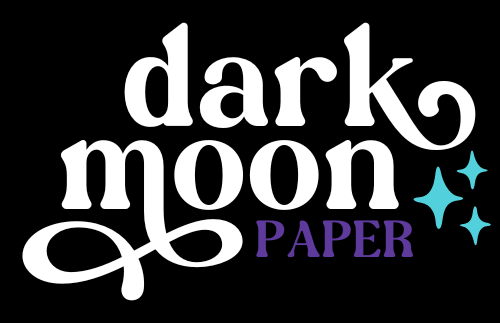
Why use planner stickers?
Planner stickers make organizing easy, fun, and personal! Add color, creativity, and structure to every page, transforming your planner into a tool that reflects you. Perfect for tracking, decorating, and staying inspired daily!
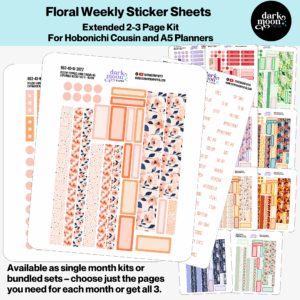
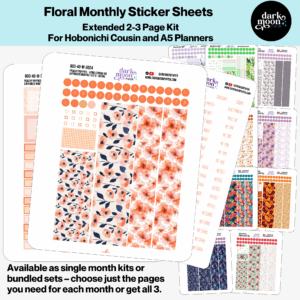
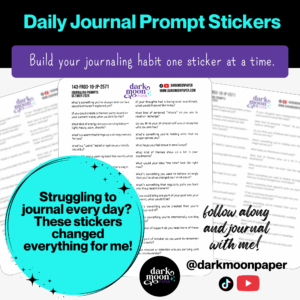
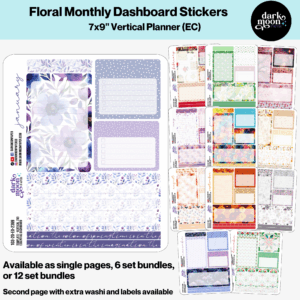
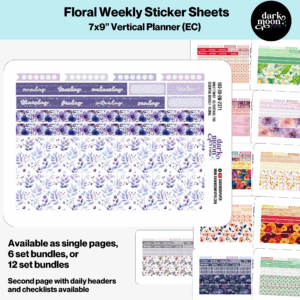
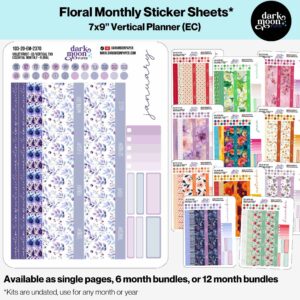
Hello and welcome!
I’m Kat, the artist behind Dark Moon Paper. I started this studio to blend my love of art, handwriting, and the small rituals that make everyday life feel magical. My sticker kits and creative resources are made to set the mood, spark ideas, and give you a little escape from the ordinary.
I create from a cozy studio in the Oregon woods, surrounded by nature and a clear view of the stars.
✨ Artistic inspiration for your planner. ✨